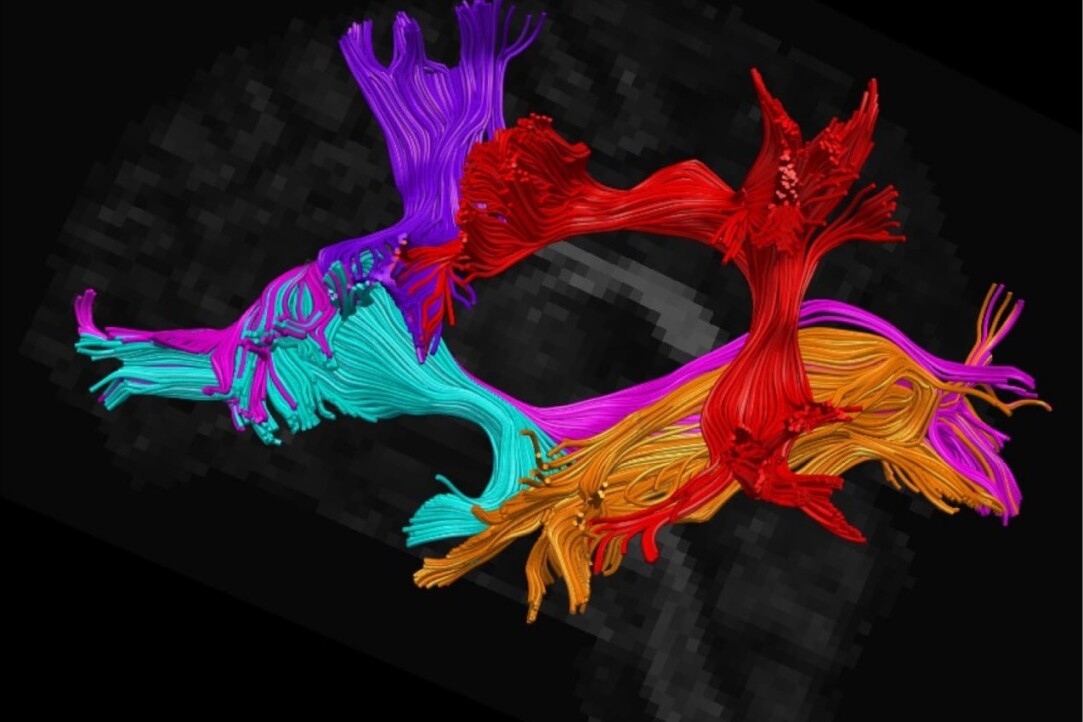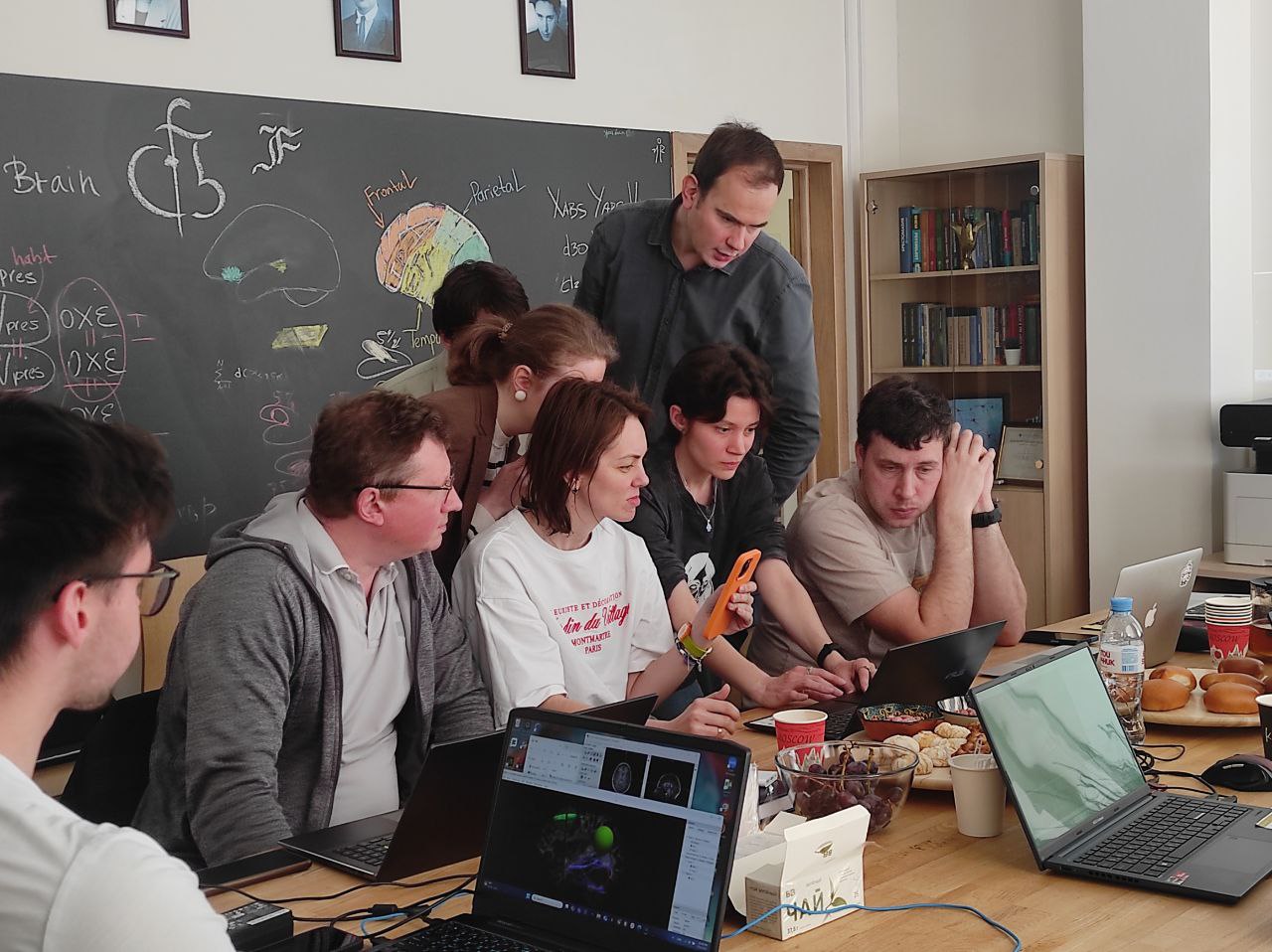HSE Scientists Explain How to Identify Brain Areas Critical for Language Function During Surgery

The HSE Centre for Language and Brain conducted a course on tractography, a method that enables visualisation of key brain connections and helps surgeons avoid damaging language-critical areas during surgery. The course was attended by neurosurgeons and radiologists from Moscow and other Russian regions who are interested in methods of preoperative language mapping.
Tractography is a technique for constructing 3D models of the brain’s pathways using diffusion-weighted MRI data. In the brain’s white matter, water primarily diffuses along nerve fibres, and this directionality can be reconstructed using specialised algorithms. One such method is diffusion tensor imaging (DTI), which allows researchers to assess the degree of water molecule diffusion alignment and to map the brain’s white matter tracts.
During the training course, participants not only discussed various theoretical issues related to preoperative and intraoperative mapping of language function and tracts but also gained hands-on experience in manually reconstructing models using the TrackVis software tool, based on pre-processed structural MRI images.
A dedicated lecture focused on linguistic tests for intraoperative mapping, a technique used by clinicians to identify language areas during surgery.
'Localising language function is a critical step in planning surgical interventions for patients with lesions in the language-dominant hemisphere. Experts at the Centre for Language and Brain have accumulated significant experience in preoperative language mapping, which minimises the risk of complications and improves the effectiveness of surgical interventions. We are pleased to share our knowledge and practical recommendations with our surgical colleagues to advance modern neurosurgery and improve the quality of patient care,' said Anna Komissarenko, Junior Research Fellow at the HSE Centre for Language and Brain.

The HSE Centre for Language and Brain has extensive expertise in providing linguistic support for neurosurgical patients. An important focus of the centre’s work is the development of specialised linguistic tests to identify functionally significant language areas during the planning and performance of neurosurgical operations. The centre’s specialists are investigating how the brain’s language function reorganises in cases of tumours and epilepsy, with special emphasis on the role of white matter pathways in supporting language function. The findings are used in both research and clinical practice—during preoperative mapping and intraoperative language monitoring. The practical course generated great interest among participants and served as a platform for interdisciplinary dialogue between neurolinguists and clinicians.
Anastasia Parshunina, neurosurgeon
'During surgery, it is essential to balance the radicality of the operation with the patient’s functional status. When removing a tumour near the language area in a patient with intact language function, it is crucial that the patient retains the ability to speak and understand speech after treatment. Therefore, the ability to reconstruct tracts is essential for preoperative treatment planning and for understanding the relationship between the tumour and functionally significant structures. The course deepened our understanding of anatomical principles and demonstrated the potential of 3D modelling for preoperative planning. We are thankful to the course organisers. During the two-day course, we gained valuable theoretical knowledge and practical skills in reconstructing pathways using the TrackVis software.
The Centre for Language and Brain thanks all course participants and invites everyone to stay updated on upcoming courses and educational programmes.
See also:
New Method for Describing Graphene Simplifies Analysis of Nanomaterials
An international team, including scientists from HSE University, has proposed a new mathematical method to analyse the structure of graphene. The scientists demonstrated that the characteristics of a graphene lattice can be represented using a three-step random walk model of a particle. This approach allows the lattice to be described more quickly and without cumbersome calculations. The study has been published in Journal of Physics A: Mathematical and Theoretical.
Scientists Have Modelled Supercapacitor Operation at Molecular and Ionic Level
HSE scientists used supercomputer simulations to study the behaviour of ions and water molecules inside the nanopores of a supercapacitor. The results showed that even a very small amount of water alters the charge distribution inside the nanopores and influences the device’s energy storage capacity. This approach makes it possible to predict how supercapacitors behave under different electrolyte compositions and humidity conditions. The paper has been published in Electrochimica Acta. The study was supported by a grant from the Russian Science Foundation (RSF).
Designing an Accurate Reading Skills Test: Why Parallel Texts are Important in Dyslexia Diagnosis
Researchers from the HSE Centre for Language and Brain have developed a tool for accurately assessing reading skills in adults with reading impairments. It can be used, for instance, before and after sessions with a language therapist. The tool includes two texts that differ in content but are equal in complexity: participants were observed to read them at the same speed, make a similar number of errors, and understand the content to the same degree. Such parallel texts will enable more accurate diagnosis of dyslexia and better monitoring of the effectiveness of interventions aimed at addressing it. The paper has been published in Educational Studies.
HSE University Launches Development of Domestic 6G Communication Technologies Based on Sub-Terahertz Microelectronics
HSE University has launched a large-scale research and engineering initiative to develop domestic technologies for next-generation 6G communication systems. The project is being carried out by the team of the Strategic Technological Project 'Trusted 6G Communication Systems Technology Suite' implemented under the Priority 2030 programme.
A Space for Economic Experimentation: LEEF Organises Workshop for Early-Career Researchers
In early September 2025, the renewed Laboratory for Experimental Economics and Finance (LEEF) held its first workshop for early-career researchers. Its main distinguishing feature was that every presentation was based on the results of laboratory economic experiments. In particular, the speakers discussed what people consider a fair deal, how best to motivate employees, and how genes influence the willingness to cooperate and help others. All interested students and postgraduates were invited to collaborate with the laboratory.
Intellectual Capital in the Face of Shocks: Russia and Iran Explore Internationalisation
In today's issue of Schola, Mariya Molodchik, Senior Research Fellow at the International Laboratory of Intangible-Driven Economy and Professor at the School of Economics and Finance at HSE University’s Campus in Perm, discusses a joint project with Iran University of Science and Technology, titled 'Internationalization of Companies from Developing Countries: The Role of Intellectual Resources in Response to Exogenous Shocks.'
HSE Researchers Introduce Novel Symmetry-Aware Neural Network Architecture
Researchers at the HSE Laboratory for Geometric Algebra and Applications have developed a new neural network architecture that can accelerate and streamline data analysis in physics, biology, and engineering. The scientists presented their solution on July 16 in Vancouver at ICML 2025, one of the world's leading conferences on machine learning. Both the paper and the source code are publicly available.
Students from HSE and Other Universities Carry Out Research Expedition at New Chersonesos
As part of the Rediscovering Russia student expedition programme, HSE University organised a research trip under the framework of the School for Young Humanities Scholars to the New Chersonesos museum and church complex in Sevastopol. The results of this expedition will form the basis for proposals on educational projects aimed at shaping young people’s historical memory of the role of Chersonesos, Crimea, and the Byzantine legacy in the history of Russian culture and statehood.
HSE Researchers Determine Frequency of Genetic Mutations in People with Pulmonary Hypertension
For the first time in Russia, a team of scientists and clinicians has conducted a large-scale genetic study of patients with pulmonary arterial hypertension. The team, which included researchers from the International Laboratory of Bioinformatics at the HSE Faculty of Computer Science, analysed the genomes of over a hundred patients and found that approximately one in ten carried pathogenic mutations in the BMPR2 gene, which is responsible for vascular growth. Three of these mutations were described for the first time. The study has been published in Respiratory Research.
First Caucasus School on Experimental Research and Cognitive Sciences Takes Places in Adygea
On September 17–20, 2025, the First Caucasus School on Experimental Research and Cognitive Sciences took place at the Gornaya Legenda venue of Adyghe State University (ASU). The event was organised by the ASU Experimental Linguistics Laboratory, the HSE Centre for Language and Brain, and the HSE Centre for Sociocultural and Ethnolinguistic Studies. The school brought together over 50 participants—students, doctoral candidates, and early-career researchers from across Russia, along with lecturers and speakers from France, Serbia, China, Turkey, Kazakhstan, and Uzbekistan.



